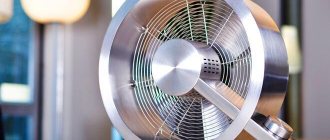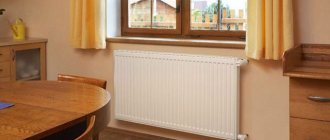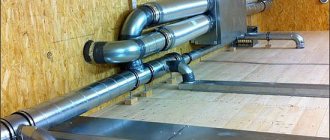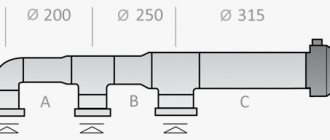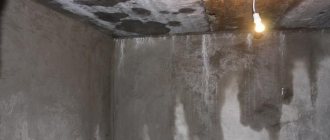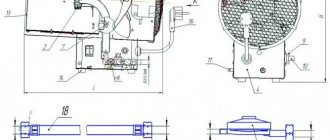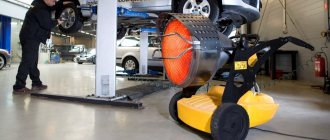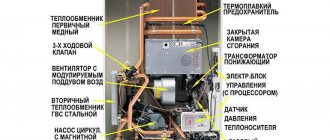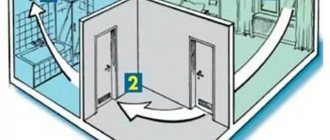How to find out the fan performance
Modern fan
When purchasing a ventilation device, everyone wants to know and check its performance. The productivity of the described device is the volume of air pumped over a certain unit of time. That's why everyone wants to buy a device with more performance! It is measured in “CFM”, which means cubic feet per minute or m³ (cubic meters) per hour.
An equally important characteristic of this device is its power, which is measured in “kW” and “kW”. In this case, the variable value is the rotation speed, measured in the number of revolutions produced per minute.
Calculation of the fan, or rather its performance, also involves:
- blade diameter;
- noise level;
- full pressure.
The fan performance is indicated on the packaging of the device or stated in the instructions supplied with it. Normally, such a device refreshes the air in the room every 4 minutes. An important indicator is the volume of available space. The larger it is, the greater the load on the described device. By the way, you can calculate the volume of a room where you need to “renew the air” using a simple school formula: multiplying the height by the width and length!
The required shift rate recommended by SNiP is the range from 10 to 12 times per hour. By multiplying the available volume of the room by any value from this range, you can obtain the required performance in a separate room. By summing the resulting value with calculations of the area for all rooms of the house, you can find out the required productivity for the entire living area.
In practice, the standards required by calculations are rarely implemented, so in real conditions everything is somewhat different, which concerns good air flow. So, for the minimum established rate of air exchange in a room, it is enough to open a window or rely on the draft created in the ventilation duct.
Kitchen exhaust fan
Bathrooms and kitchens require fans with higher performance or they must run longer here than in other rooms, since taking a shower and cooking leads to a change in the composition of the air, saturating it with water vapor and carbon monoxide. For such rooms, the operation of the device in a “reinforced hood” is suitable, which must be installed on the device.
An important role is played by the installation of an axial fan, which is a bladed blower that transmits mechanical energy from the rotation of the blades located on the impeller in the form of kinetic and potential energy. Calculation of the air exchange of axial fans is carried out taking into account the efficiency (efficiency factor), aerodynamic characteristics of the device and unit performance. This value may also be indicated in the instructions supplied with the device.
Description of calculations of blower machine parameters
The calculation of any type of ventilation unit is carried out according to individual aerodynamic characteristics, and an axial fan is no exception. These are the characteristics:
Installation of axial fan.
- Volume flow or productivity.
- Efficiency.
- The power required to drive the unit.
- The actual pressure developed by the unit.
The performance was determined earlier when the ventilation system itself was calculated. The fan must provide it, so the air flow value remains unchanged for calculation. If the air temperature in the working area differs from the temperature of the air passing through the fan, then the performance should be recalculated using the formula:
L = Ln x (273 + t) / (273 + tr), where:
- Ln – required productivity, m³/h;
- t – temperature of air passing through the fan, °C;
- tr – air temperature in the working area of the room, °C.
How to increase fan performance
The presence of fresh air in the premises is the key to good work and excellent well-being of all household members. This can be organized by installing fan equipment in the room that can evenly cool the room. At the same time, its quiet operation, which does not create discomfort for others, is important.
It is desirable to create an unimpeded flow of air from the ceiling to the floor, which could be freely distributed around the entire perimeter of the room. Thanks to this, the device will heat up less and its performance will increase.
From a school physics course we know that cold air occupies the bottom of the room, and hot air occupies the top. Therefore, it is recommended to install an air outflow at the bottom of the room. The presence of active air outflow and inflow requires the installation of exhaust/injection fans of equal performance.
Ventilation system
You can increase the performance of the fan by switching it to efficient operation mode. In this case, the operation of the device should be minimal when household members are not at home. In other situations, it is recommended to increase the air supply in the room where people are. If there is an active cooking process in the kitchen and the shower is running for a long time, it is recommended to increase the local air supply in these rooms to the maximum. Such “smart” ventilation can quickly and efficiently exchange air in any room.
For the described ventilation system, a special control unit is equipped, which is connected to the processor. Sensors that can detect:
- degree of movement;
- amount of carbon dioxide;
- relative air humidity.
Responsible for the selected operating mode is the “control unit”, which sets the operating mode for the exhaust pumps. These devices can serve one or several rooms. The number of such devices depends on the area of the room. The hood from the kitchen is also connected here.
Kitchen hood
The advantage of using the described “smart” ventilation system is the correct regulation of the performance of exhaust fans, allowing you to reduce the amount of air pumped over 24 hours by almost half. It also consumes less electricity, which is a big plus for family budgets.
Main types of electric motors
There are many types and modifications of electric motors. Each of them has its own power and other parameters.
The main classification divides these devices into DC and AC motors. The first option is used much less frequently, since its operation requires the presence of a direct current source or a device that converts alternating voltage into direct current. Fulfilling this condition in modern production will require significant additional costs.
But, despite significant disadvantages, DC motors have a high starting torque and operate stably even at high overloads. Due to their qualities, these units are widely used in electric transport, in the metallurgical and machine tool industries.
However, most modern equipment runs on AC motors. The operation of these devices is based on electromagnetic induction, which is created in a magnetic field by a conducting medium. The magnetic field is created using windings flowing around currents or using permanent magnets. Electric motors operating on alternating current can be synchronous or asynchronous.
The use of synchronous electric motors is practiced in equipment where a constant rotation speed is required. These are DC generators, pumps, compressors and other similar installations. Different models differ in their own technical characteristics. For example, the rotation speed can be in the range of 125-1000 rpm, and the power reaches 10 thousand kilowatts.
Many designs have a short-circuited winding located on the rotor. With its help, if necessary, an asynchronous start is made, after which the synchronous motor continues to operate as usual, minimizing electrical energy losses. These engines are characterized by their small size and high efficiency.
Asynchronous AC motors have become much more widespread in the manufacturing sector. They are characterized by a very high frequency of rotation of the magnetic field, significantly exceeding the speed of rotation of the rotor. A significant disadvantage of these devices is considered to be a decrease in efficiency to 30-50% of the norm at low loads. In addition, during start-up, the current parameters become several times greater compared to operating indicators. These problems are eliminated by using frequency converters and soft starters.
Asynchronous motors are used in those facilities where frequent switching on and off of equipment is required, for example, in elevators, winches, and other devices.
How to measure fan performance
A lot depends on the performance of the ventilation system: both the condition of the house and its general well-being. Thus, constant ventilation of the home by opening windows leads to condensation on the windows and walls, and also stimulates the formation of mold in the corners. An insufficient supply of fresh air negatively affects the condition of human lungs, manifesting itself in the development of corresponding diseases and pathologies. Children growing up without ventilation can compromise their health for the rest of their lives.
To measure the performance of a ventilation system, you can use the following methods:
Measuring room parameters
- Self-measurements. Using a tape measure, measure the size of the room, determining its volume in meters. You can use a simple school formula to calculate the area of a room: the product of height, width and length. The result obtained should be expressed in meters, which will be the total volume of the room.
- Obtaining information from reliable sources. BTI documents contain all the necessary information about the area of premises. The volume of all housing and heated area is given there. You can also find the height from ceiling to floor and calculate the volume of a separate room.
Next, the value characterizing air exchange is calculated. In this case, the volume of a separate room should be multiplied by the required number of air updates occurring within an hour. The number of air updates can be found in building codes and regulations (SNiP).
In this case, you should take the maximum number of updates in order to more accurately calculate the required power of the exhaust duct.
At home, the required ventilation device is selected based on the resulting air exchange area. Standard ventilation ducts have a low air exchange capacity. The situation can be helped by installing a recirculation exhaust system that can pass air through filters, sending it back into the room.
Scheme of installation of natural and forced ventilation
If the house does not have a ventilation duct, then the exhaust fan can be installed in a wall opening or on the ceiling. The junction of the ceiling and wall is also suitable for these purposes. In this case, you can install a device with a lower power value.
Exhaust ventilation in the kitchen
Thanks to kitchen exhaust ventilation, it is possible to carry out air exchange in the most problematic areas of the room. For example, improving the air quality in the kitchen during food preparation. Not only the general well-being of the people living here, but also the condition of the walls in the living space depends on the use of such structures. Technical standards recommended by SNiP for organizing ventilation:
- 60 m³ per hour (electric stove);
- 100 m³ per hour (gas hobs).
This value should be multiplied by the area of the room to find out the required performance of the ventilation system. It is based on the obtained value that a device with an appropriate electric motor should be selected. Installing a hood above the hob allows for additional air exchange, preventing the spread of food aromas throughout the home. When connecting these elements, you should select all components correctly, with equal sections.
When the kitchen hood is installed correctly, the ventilation shaft with the attached device is connected. Thanks to this, the harmful chemical compounds formed during cooking are completely removed from the component.
